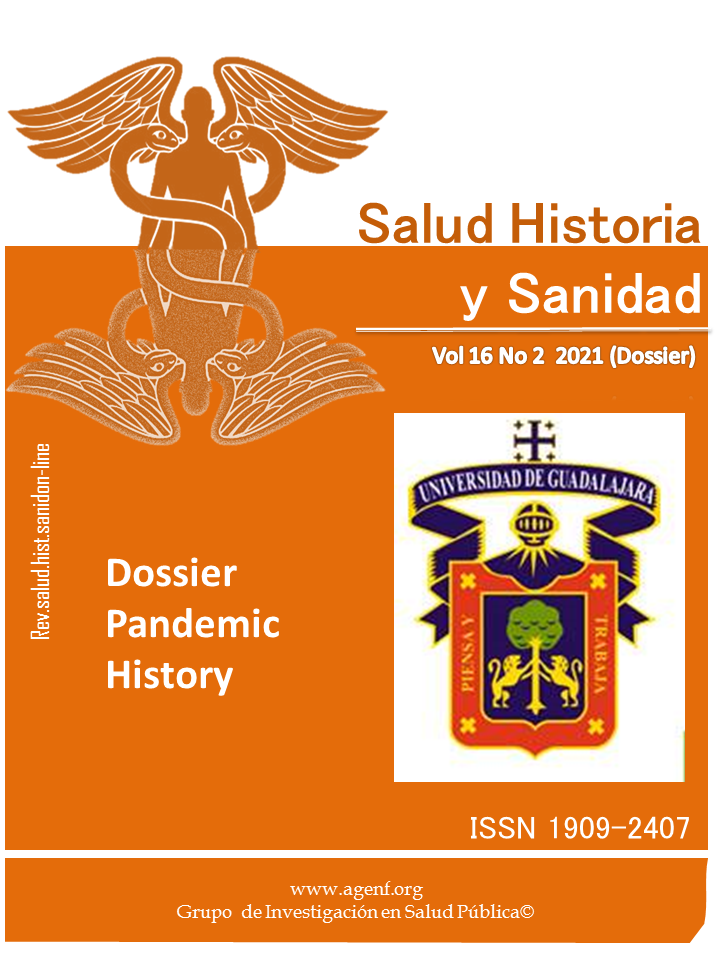Abstract
The presence of epidemic outbreaks of poliomyelitis in the initialand central decades of the twentieth century constituted a ma-jor public health problem aggravated by affecting children, thelack of effective treatments and by paralytic sequelae. The ob-jective of the work is to analyse some of the responses that werecarried out from health professional fields and alternative hete-rodox approaches in the most critical stages of the epidemic, indifferent places and that, among other factors, they were moti-vated by a compassionate approach. This study follows the typi-cal methdological approach in a sicentifc historical study, witha critical use of primary sources and of their contextualized in-terpretation.. The main results provide a wealth of empirical in-formation on the importance of compassion in the developmentof the specific measures adopted . The conclusions point to adirect cause-effect relationship in interventions such as the ironlungs or the Kenny method in order to alleviate and improve thequality of life of children in the stage prior to the developmentof polio vaccination
References
Smallmann-Raynor M, Cliff A, eds..Poliomyelitis. A world geography. Emergence to eradication. Oxford: Oxford UP; 2005.
Martínez Pérez J. Dossier: La poliomyelitis y sus contextos: experiencias colectivas e individuales ante la enfermedad en el siglo XX Asclepio 2009; LXI (1): 7-192.
Porras Gallo MI, Ayarzagüena M, De las Heras J, Báguena Cervellera, MJ, coords. El drama de la polio. Un problema social y familiar en la España franquista. Madrid: La Catarata; 2003.
Ballester Añon R, Porras Gallo MI, coords. Dossier:Politicas y respuestas sociales frente a la poliomieltis en Europa. Dynamis 2012; 32(2): 273-414.
Porras Gallo MI, Báguena Cervellera MJ, Ayarzagüena M, Martín Espinosa N, coords. La erradicación y el control de las enfermedades infecciosas. Madrid: La Catarata; 2014.
Àlvarez A., Do Nascimento D R, coords..Lo ganado y lo perdido después de dos décadas dessde que América Latina fue declarada zona libre de poliomyelitis. Dossier. Historia de la Poliomielitis. História, Cièncias, Saúde, Manghinos 2015; 22(3):923-1005.
Carrillo AM. La poliomielitis en México: vacunación, erradicación y síndrome post-polio, In: Rodríguez Sánchez JA, Guerra Santos I,,coords. La Memoria Paralizada. Ideología y activismo en los movimientos sociales en torno a la poliomielitis y el síndrome post-polio, Salamanca: Ediciones Universidad de Salamanca (en prensa).
Zaragoza JM, Historia de las emociones: una corriente historiográfica en expansión. Asclepio 2013; 65 (1).
Báguena Cervellera MJ, Ballester Añón R, Porras Gallo, MI. El impacto psicológico y social de la poliomielitis y sus secuelas en las víctimas. In: Porras Gallo MI et al. [op.cit. en referencia n.3], Pp. 193-210.
Aristóteles. Retórica. [ed. Madrid: Centro de Estudios Constitucionales, 1985, I, 8, 1385b3].
Shea S, Wynyard R, Lionis Ch, eds. Providing Compassionate Health Care. Challenges in policy and practice. London and New York, Routledge;2014.
Inspección General de Sanidad. Campaña de salud contra la parálisis infantil. Madrid, 1916.
Rodríguez D. Pasado, presente y futuro de la parálisis infantil. Anales de la Universidad de Valencia. Curso 1954-55. Valencia; Universidad de Valencia,1955.
Rodriguez Sanchez, JA, Seco Calvo J. Las campañas de vacunación contra la poliomielitis en España. Asclepio 2009; LXI(1): 81-116.
Aguila Maturana, AM. El debate médico en torno a la rehabilitación en España (1949-1969). Madrid , Tesis doctoral, Universidad Complutense de Madrid, 2000.
Martínez Pérez, J. Consolidando el modelo médico de discapacidad:sobre la poliomielitis y la constitución de la Traumatología y la Ortopedia en España (1930-1950). Asclepio 2009; LXI (1), Pp. 117-143.
Toledo Marhuenda JV. La poliomielitis en España (1880-1970) y su impacto sobre el desarrollo de las técnicas en Fisioterapia: un acercamiento a las discapacidades físicas y a su tratamiento. Elche: Editorial digital Universidad Miguel Hernández; 2015.
Sanchis Olmos,V. Manual de Clinica Ortopédica infantil. Barcelona/Madrid: Editorial Científico-Médica, 1940, Pp.125-126.
Wilson, DJ. And they shall walk: ideal versus reality in polio rehabilitation in the United States. Asclepio 2009; LXI(1), Pp. 175-192.
Rogers, N. Polio Wars, Sister Kenny and the Golden age of American Medicine .New York: Oxford UP, 2014. Rogers es también la autora de otros interesantes trabajos referidos a Kenny: Dirt and disease: polio before FDR . New Brunswick, NJ: Rutgers University Press; 1992 y, especialmente, ‘Silence has its own Stories: Elizabeth Kenny. Polio and the Culture of Medicine’, Social History of Medicine, 2008,;21(1): 145-161.
Fresquet, J.L. Peter J. Safar (1924-2003). Accesible en : https://www.historiadelamedicina.org/safar.html
item Porras Gallo, M.I, Ballester Añón, R.. The incorporation of medical technology for the treatment of the acute stage of poliomyelitis in Spain, Seventh European Social Science History Conference, Lisboa (Portugal); 2008.
Prugh, DE, Tagiuri, D. Emotional aspects of the respirator care of patients with poliomyelitis. Psychosom Med 16(2): 1954; 104-128.
Maxwell, J. (1971). The iron lung: halfway technology or necessary step. New England Journal of Medicine,1971;285: 1366-1388.
Stanton, J. Supported lives. in: Cooter R, Pickstone J, eds. Companion to Medicine in the Twentieth Century. London: Routledge; 2003; Pp. 607-609.
Berlant L. Compassion. The culture and politics of an emotion. New York/London: Routledge; 2004.
Re-imagining Childhood. Objects and the voice of the child. Conference. The University of Greenwich / The Society for the History of Child in the Past. 9th May 2015.
item Wilson D. Living with polio. The epidemic and its survivors. Chicago: The University of Chicago Press; 2005.
Báguena Cervellera, MJ, Porras Gallo MI, Ballester Añón R. El impacto social y pisicológico de la poliomielitis y sus secuelas en las victimas. In: Porras Gallo MI et al. [op.cit. en referencia n.3], Pp. 193-210.
Rodríguez Sánchez JA, Ballester Añón R, Porras Gallo MJ., Báguena Cervellera MJ. La experiencia de la poliomielitis desde la perspectiva de género. In: Porras Gallo MI et al [op.cit. en referencia n.3], Pp. 211-232.
item Dixon Th. Patients and passions. Languages of medicine and emotions, 1798-1950). In: Alberti FB, ed. Medicine, emotion and disease., 1750-1950. New York: Palgrave-Mc Millan; 2006, Pp. 22-52.

This work is licensed under a Creative Commons Attribution-NonCommercial-NoDerivatives 4.0 International License.
Copyright (c) 2021 REVISTA SALUD, HISTORIA Y SANIDAD
